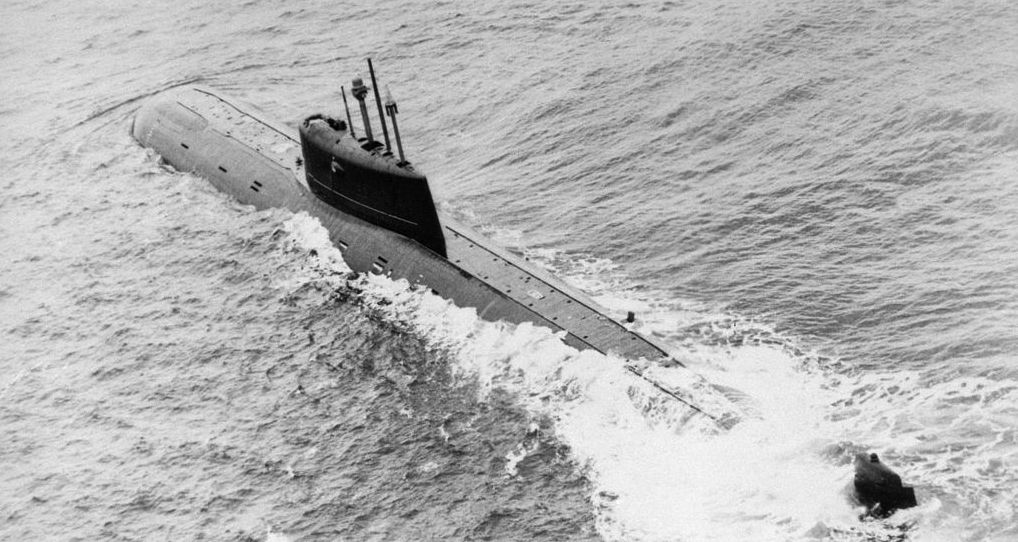Charlie-Class: Russia's Cold War Missile Submarines Were Dangerous
The Charlie-Class submarines have a tragic past as one of these vessels had a tragic accident that is remembered to this day.
The Project 670 Skat submarine, known to NATO as the Charlie-class, was a Soviet nuclear-powered cruise missile submarine. The Charlie, which operated in the 1960s and 70s, has long since been decommissioned, and today serves as a symbol of the Cold War’s peak.
The origins of the Charlie-Class Submarine program
According to the Federation of American Scientists (FAS), the Charlie-Class was “originally planned as a small, “mass-production” submarine that would be the lower-cost complement to the more expansive PAPA design, which clearly could not be built in sufficient numbers.”
In 1967, the first Charlie was launched at Krasnoye Sormovo shipyard at Gorkiy. The Charlie-class was notable for its use of submerged launch antiship missiles. Actually, the Charlie was the very first Soviet submarine to use submerged launch antiship missiles
. The Charlie was also the first Soviet submarine to use one nuclear reactor and one propeller shaft – a design that was shared with American submarines. Except for the Charlie, all other Soviet submarines of the period used two reactors and two propellers.
The use of a single reactor and propeller did have some drawbacks, however. “With only a single reactor (VM-4 type water-cooled), the Charlie-class was limited to a top speed of 24 knots, which was insufficient to keep pace with a 30-knot carrier battle group,” according to FAS. On the upside, the Charlie did seem improved relative to the Echo-class Soviet submarines.
Originally, the Charlie-Class was slated to carry the SS-N-9 anti-shipping cruise missiles. However, the SS-N-9 was not developed in time to be used with the Charlie. So, instead, the Charlie was outfitted with the SS-N-7 – a modified version of the SS-N-2 Styx. Later, when the Charlie was upgraded to the Charlie II variant, the SS-N-9 was included.
The SS-N-9, with a 60-mile range, offered a significant improvement over the SS-N-7, which had a 30-mile range.
The Charlie II was an improved variant built between 1972 and 1979. The Charlie II, also built at Gorkiy, featured an 8 meter insert in the hull forward of the fin. The insert was designed to house electronics and launch systems, used for targeting and firing of the SS-N-9 anti-ship missile.
“The slower construction rate of the Charlie II suggested that the design was deemed less than satisfactory,” FAS reported. “Indeed, the Charlie SSGNs were by far the smallest class of the second generation of Soviet nuclear submarines which, also included 49 Victor SSNs and 76 Yankee/Delta SSBNs.”
In all, six Charlie II submarines were made.
Mishap at sea
In June 1983, Charlie-class submarine K-429 was running tests in Sarannaya Bay. K-429’s Captain First Rank, Nikolay Suvorov, ordered the crew to dive to periscope depth. However, Suvorov did not give the preliminary command to set the diving watch – so, the crew did not align the boat’s systems for sea, nor did the crew man their stations as the K-429 began to dive.
Since the K-429 had not been properly prepared to dive, the submarine’s instrumentation valves were not aligned. As a result, even though the main ballast tanks were filling, the instrumentation valves indicated that the main ballast tank remained empty.
Suvorov, reading that the ballast tanks were still empty, ordered that the auxiliary tanks be filled. As the auxiliary tanks filled (in addition to the already filled main ballast tank) the K-429 over-ballasted to about 60 tons negative buoyancy – which caused the submarine to dive aggressively.
As it happened, the K-429 was just returning from the shipyard, where her ventilation system had been opened to the maximum extent (to exhaust welding-related fumes). Resultingly, interlocks that normally would have automatically closed shut were left open. With the ventilation system left wide open, the quickly diving K-429 took on water immediately, flooding the forward compartments.

Suvorov ordered the K-429 to execute an emergency ballast blow, yet a crewmember misunderstood the order and instead, shut the flood volves on the bottoms of the ballast tanks while opening the ballast tanks on the tops of the tanks.
As a result, half of the K-429’s high-pressure air was wasted through the vents without displacing any water. The forward compartment continued to flood, filling with 420 tons of water, drowning 14 men. The boat continued to sink, before coming to a rest at the bottom of the bay, 39 meters below the surface of the Bay.

Two crewmen escaped from a trunk in the torpedo room and ascended to the surface, before swimming to shore. Upon arriving to shore, military police arrested the two men, who were able to report the sunken submarine. Rescue ships were dispatched, and the rest of the crew swam from the ship to the surface. Two men died during the ascent, but the rest of the crew was successfully rescued.
Suvorov was sentenced to ten years in prison.
About the Author
Harrison Kass is a defense writer with over 1,000 pieces published. An attorney, pilot, guitarist, and minor pro hockey player, Harrison joined the US Air Force as a Pilot Trainee but was medically discharged. Harrison holds a BA from Lake Forest College, a JD from the University of Oregon, and an MA from New York University. Harrison listens to Dokken.
All images are Creative Commons.


